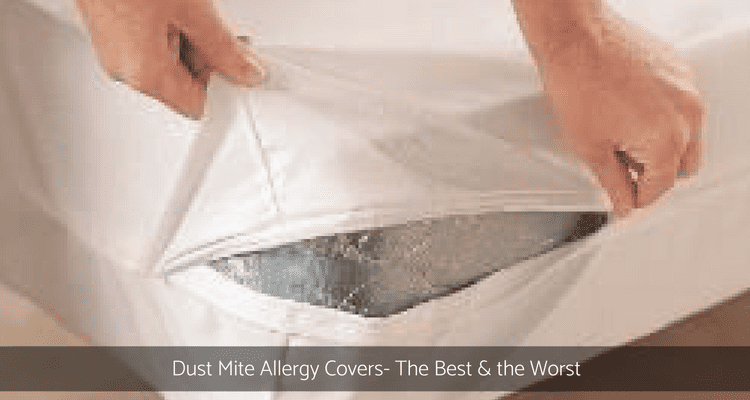 Do You …
Do You …
- wake up in the morning, sneeze continuously, have that persistent runny and stuffy nose?
- look at yourself in the mirror and see dark circles under your eyes, your nose is itchy, subconsciously you are rubbing your sleeve over it?
- get ready for work, make your bed, only to feel wheezy and tight in the chest?
Then once you leave the house … you feel fine.
You’ve been to the doctor and he’s recommended encasing your mattress and pillows with dust mite covers or allergy protective bedding.
You’re unsure where to start, which brand or product do you choose. There appears to be more and more anti dust mite bedding products on the market than ever before, promoting dust mite resistance and reducing their allergen levels.
Since there is no cure for dust mite allergy sufferers and dust mites are part of our every day life, it is essential to control their activity. You may wish to consider this, majority of dust mites in the home environment are found in bedding, that is the best place to start.
A dust mite protector on your mattress or pillow cuts off the dust mites’ food source (your skin cells) and at the same time reduces breathing in their allergens (droppings).
There are several dust mite resistant covers available in the retail and health arena for mattresses, pillows, doonas and quilts to reduce your family’s exposure to house dust mites.
So How Do You Really Know?
Which brand should you invest in and will it be effective in dust mite control?
In the past, protective dust mite covers were only available in plastic, making you feel sweaty and the noise of the “crackling” plastic would drive you crazy. Fortunately, technology has improved with new fabrics completely preventing allergens passing through the tightly woven, impermeable fabric.
At the same time, the materials are breathable, allowing air flow and perspiration through, providing comfort and a good night’s rest without feeling clammy and hot. You will not even know they are there!
Or Do You?
Most anti dust mite fabrics are made from synthetic materials such as nylon, acrylics or poly-cotton blends. Many use chemicals and dyes in the manufacturing process.
Whilst they may be effective at reducing house dust mite levels, they are inappropriate if you or your child is chemically sensitive. Similarly, if you are inclined to be a “warm to hot sleeper” as I call it, sleep is disturbed as you feel hot and bothersome when the cover is in place.
These materials contribute to trapping heat and moisture and encourage overheating during rest periods. Comparably, just check the labels of your current bed sheets … if you’re sleeping between polyester or mixture blend sheets, they may tend to feel warmer to sleep with too.

I like the feel of natural fibres such as 100% cotton and 100% silk (AllerProtect and Dream Silks). Cotton is a more natural, cooler feel. Bedding that has specifically not been treated or dyed are especially highly sought after by our chemical sensitive and “hot body” families, as well as those who suffer from eczema.
Some dust mite bedding control fabrics are made with a membrane, a vinyl or urethane based coating on the inside. You can’t see a thread or pore but provides the same relief from dust mites.
By purchasing the cheapest covers on the market this may compromise your family’s health. Sometimes, bedding covers made from similar looking fabrics are offered for sale as allergen barrier covers, a fabric with relatively large, uneven gaps between the fibres. Needless to say, while the price of these covers may seem attractive, they do not provide an effective barrier to the dust mite allergen.
Choose only those fabrics specifically developed, tested and proven as a barrier against dust mite allergens.
The material’s pore size, that is the space or opening between the intersected, woven fibres, needs to be at least 6.1 microns. The fibres are so tightly woven, that it blocks dust mite allergens to below detectable levels. That is, you don’t even know they are there. Dust mites and their faeces are larger at 10-40 microns in diameter.1
According to World Allergy Organisations avoidance measures need to be complete to achieve successful outcomes. Testing the effects of covers only, is unlikely to succeed and indeed did not achieve significant decreases in mite allergens over time.
The dust mite mattress cover and dust mite pillow covers need to be air permeable so as air and moisture can transmit readily through the fabric leaving you cool and comfortable all night long.
HOW TO
Independent Testing
It’s one thing to say your product is natural and healthy, but another to back it up with third-party independent certifications that shows how Mitey Fresh is committed to providing transparency of our products and their manufacturing processes.

Dust mite covers will assist in reducing your exposure to dust mites while you sleep and provide welcome relief.
The Best Allergy Covers:
- Are naturally comfortable, preferably 100% cotton – the AllerProtect Range.
- Are less than 10 µm pore size (tested), preferably 6.1 µm pore size – the Mite Guard Range – or below at 4.5µm pore size – the AllerProtect Range. Precision micro-weave technology is the correct term.
- Are tested and proven by independent studies – both AllerProtect and MiteGuard Ranges fit this criteria.
- Totally encase the whole mattress with a zipper. Ditto!
- Strong fabric-taped seams and high-quality zips as seen in the AllerProtect range – simply adds durable strength, longevity and customer relief knowing every gap is covered.
- Not even a dust mite or its poos can get through the stitching from the needle holes.
- Don’t be misled with mattress covers that are fitted with elastic style, they simply don’t cover up, excuse the pun!
To determine further product efficacy, the material used to manufacture our AllerProtect cover range has been tested by an independent reference laboratory and proven to form an effective barrier to house dust mite allergen down to 4.5 µm. The construction methods used in AllerProtect have also been tested by the laboratory. They could detect no allergen leakage through the seams.
PRODUCT:
Allerprotect Dust Mite Bed Set
Create a barrier between you and the dust mite allergens by enclosing the entire mattress, the entire pillow and the entire doona. Provides asthma and allergy relief by stopping the continual night time exposure to dust mite allergens while you sleep.

How Do You “Cover” Your Home?
These are just some of the top ways to be an expert allergy cover owner. What are some of your best tips for keeping your bedding fresh and healthy while keeping the dust mite environment on your mind? I encourage you to have conversations about allergy covers at your place and share or ask questions on the Mitey Fresh Facebook page, other people may well be wondering the same thing, and I will do my best to answer them there. Or please call me directly on the land line 02 9986 3432. Towards healthier living, Carol Parr ♥
Sources:
1. Reference 1999 a team of researchers at the University of Virginia Asthma and Allergic Diseases Centre, Charlottesville, VA, USA published a study “Evaluation of materials used for bedding encasement: Effect of pore size in blocking cat and dust mite allergen.” http://onlinelibrary.wiley.com/doi/10.1034/j.1398-9995.2003.00095.x/full
2. http://www.worldallergy.org/professional/allergic_diseases_center/allergen_avoidance/
3. IBT reference laboratory, Lexana, Kansas, USA Report 2003
4. IBT reference laboratory, Lexana, Kansas, USA Report 2000
Author
-
We’re glad you’re here. We’re Carol and Tony, founders of one of the longest running Healthy Home Blogs in the world, Mitey Fresh Australia. We’ve been on this journey for the last 25 years and are passionate about helping families sift through health hazards and triggers like allergens, mould, water damage, chemicals and EMFs, to get clarity about what’s toxic and what’s not so they can create a healthy and happy home for their family they love. Each month, people visit this blog seeking focus on the health and wellbeing of their loved ones, sustainable and effective practice tips and guides, to help create and manage healthier indoor spaces, improve the built environment that is pleasing to the senses and support healthy living and nature, every day. Starting this blog was to help change people’s lives, one family at a time, and we can’t wait to share how its allowed us to stand next to you and show you how interpreting these synergies between buildings and the environment they are built in will impact upon the health and well-being of those who occupy them. Find out more about Healthy Homes and what this blog can do for you!
View all posts






Hi there
My daughter has been diagnosed with a probable dust mite allergy. Our doctor has suggested a new mattress and pillow is best, along with your covers – however might cutting ‘off the dust mites’ food source (your skin cells) and at the same time reduces breathing in their allergens (droppings)’ with the covers alone be sufficient, on her current mattress rather than a new one? Happy to get her a new pillow, however would be wasteful to consider a new mattress as it is perfectly fine otherwise.
Many thanks for your expert advice.